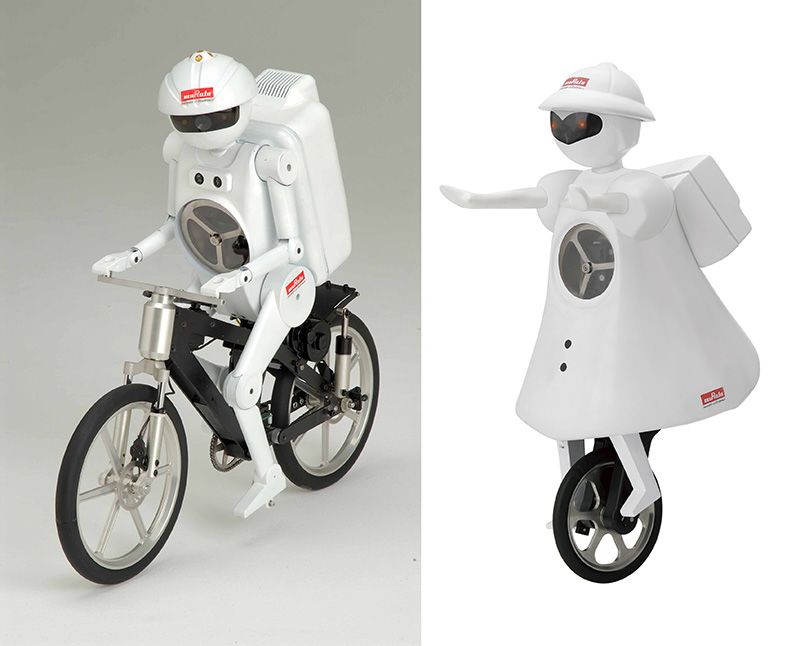
Japan’s Robots: Becoming More Human
Famous Faces
Science Technology Society Lifestyle- English
- 日本語
- 简体字
- 繁體字
- Français
- Español
- العربية
- Русский
Walking Through Crowded Spaces: Honda’s ASIMO
 Photographs and videos courtesy Honda Motor Co., Ltd.
Photographs and videos courtesy Honda Motor Co., Ltd.
Honda Motor developed its robot, ASIMO, for use in people’s living spaces. Its size is big enough so that it can use furniture and tools while remaining small enough to be non-intimidating. Since its 2000 creation, it has seen a steadily increasing range of capabilities thanks to the efforts of Honda engineers. The latest ASIMO model, introduced in 2011, is capable of independent motion, without needing intervention from humans; the robot instead uses input from its sensors to decide where and how it will move next.
Descending from the stage at its first demonstration, the 2011 ASIMO took steps into a space where people were passing back and forth. The robot then displayed its ability to walk through crowded areas, avoiding the people it encounters. Overseas journalists on hand to cover the launch reportedly joked with Honda employees that there must be a human hidden inside.
Specifications
| Size | Height | 130cm |
| Width | 45cm | |
| Depth | 34cm | |
| Weight | 48kg | |
| Abilities | Max speed | 9 km/hr |
| Operating time | 40 mins (while walking) |
Places to Meet ASIMO
Suzuka Circuit Land (Suzuka, Mie Prefecture, Japan), Twin Ring Motegi (Motegi, Tochigi Prefecture, Japan), Welcome Plaza on the ground floor of Honda’s headquarters in Aoyama (Tokyo), National Museum of Emerging Science and Innovation (the Miraikan, Tokyo), and Disneyland (California, United States).
The Singing and Dancing Robot: HRP-4C
 Photographs and videos courtesy the National Institute of Advanced Industrial Science and Technology.
Photographs and videos courtesy the National Institute of Advanced Industrial Science and Technology.
The HRP-4C is a robot that you might mistake for a human. Engineers at AIST, the National Institute of Advanced Industrial Science and Technology, built it based on the measurements of an average young Japanese female. The measurements took into account not just overall dimensions but also the positioning of joints throughout the body. The HRP-4C’s movement is based on data collected with motion capture equipment from actual humans walking and moving their bodies. The robot can also recognize human voices using a built-in microphone and can even engage in conversation.
Judging that a walking humanoid robot wouldn’t have enough commercial value by itself and would be difficult to mass produce, the creators decided to target the entertainment industry and focused on making the shape, movements, and reactions of HRP-4C as close as possible to those of a human. The hope was to develop a robot that could be used in fashion shows and other events. This hope was fulfilled in 2009 when the HRP-4C was unveiled at a show, singing and dancing on stage.
Specifications
| Size | Height | 158cm |
| Weight | 43 kg (including battery) | |
| Other properties | Number of joints | 42, including humanlike joints in the hips and lower back to allow natural walking movements |
Places to Meet HRP-4C
AIST representative: “None planned at present.”
Cycling Sibling Robots
 Photo courtesy Murata Manufacturing Co., Ltd.
Photo courtesy Murata Manufacturing Co., Ltd.
Specifications
| Murata Boy | Murata Girl | ||
|---|---|---|---|
| Size | Height | 50cm | 50cm |
| Weight | About 5 kg | About 6 kg | |
| Other properties | Movement ability | Rides a bike. When it stops, it can balance itself without using its legs. Can ride along a balance beam. | Rides a unicycle. Can ride along a balance beam. |
| Moving parts | Neck, arms, legs | Neck, legs | |
Places to Meet Murata Boy and Murata Girl
CEATEC Japan Electronics Exhibition (Makuhari Messe, Chiba Prefecture, Japan), Consumer Electronics Show (Las Vegas, Nevada, United States). The robots also appear at other scientific events where robotics is a theme.video movie tourism Tokyo robot Mie Honda event AIST humanoid ASIMO Suzuka Circuit Disney Land HRP-4C Murata Boy Murata Girl Murata Manufacturing Company CEATEC CES technology exhibition Mie Prefecture Twin Ring Moteg